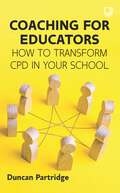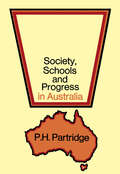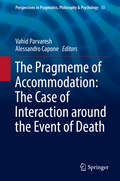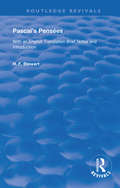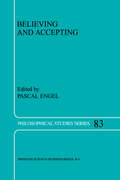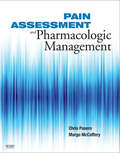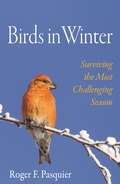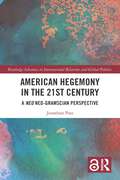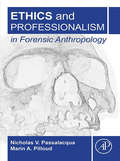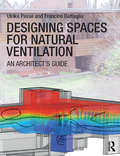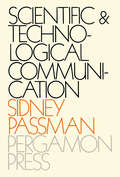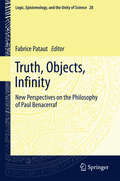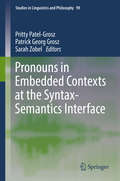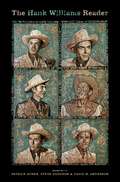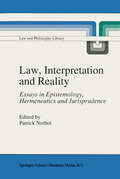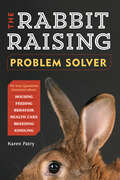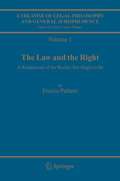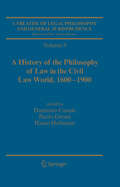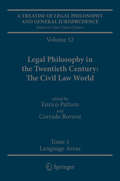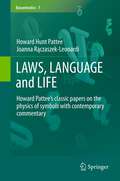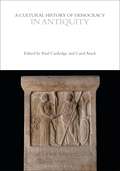- Table View
- List View
Ebook: Coaching for Educators: How to Transform CPD in Your School
by Duncan PartridgeHow can professional development in schools be designed to meet the specific needs of every individual? What approach to teacher improvement has been proven to have more impact than traditional training models? Which form of professional learning has the greatest impact on workplace wellbeing? Coaching for Educators answers all of these questions by providing a succinct and focused guide, which positively demonstrates how to make coaching work in schools. This book:•Provides up to date research summaries on the impact of coaching in educational settings•Shares practical suggestions and strategic guidance around inclusive practice and professional wellbeing•Uses case studies and practical examples to illustrate successful coaching based CPD•Can be adapted to the needs of each and every schoolOffering practical insights into CPD for all professionals, education practitioners and postgraduate students looking to expand their learning, this book is for anyone seeking to gain insight into best practice and develop their leadership skills. Coaching for Educators will provide you with the tools to develop a culture which empowers teachers and leaders to get better every day.“A brilliantly personable journey into coaching.”Karen Wespieser, MBE; Chief Operating Officer, Teacher Tapp, UK“[An] intellectually stimulating yet jargon-free read.”Dawn Grant-Skiba, Teacher and Coaching in Schools Researcher, Australia“This book provides a compelling case for the power of coaching as an effective form of professional development.”Cat Scutt, Director of Education and Research, Chartered College of Teaching, UK“A well-researched, thorough and practical guide to effective coaching in schools.”Richard Parker, Headteacher, International School of London, UKDuncan Partridge is a qualified coach and MD of Educe Mentoring & Coaching. Prior to this, Duncan held school headship positions in Argentina, Italy and the UK, as well as Director of Education roles at the English-Speaking Union and the Skills Builder Partnership. Duncan has an MA in International Education and Leadership.
Society, Schools and Progress in Australia
by P. H. PartridgeSociety, Schools and Progress in Australia concerns the study of developments in the educational system and decisions affecting it in Australia. This book is part of a series on the same subject involving several countries or regions. This book deals with the main features of the educational system inherited from the United Kingdom and applied in Australia in terms of transformation, modification, and technological advances. After giving a description of the background of education, this book discusses the organization of public education in Australia: secondary education; administrative centralization; and the role of the commonwealth, States, and local communities. This book then reviews the assumptions and philosophies that seem to have influenced the direction and growth of education in the country. This text considers the independent schools, education and equality, leading issues in secondary education, and the influence of universities and catholic schools. This book also examines the patterns of higher education, notably at the university level, the British influence, and postgraduate and research work. This text addresses technical education, adult education, and teacher training. This book then evaluates the broad features of Australian education, the bureaucracy, social change, and some aspects for national development. Education ministers and policymakers, school administrators, city and state officials, and sociologists will find this book very informative.
The Pragmeme of Accommodation: The Case of Interaction around the Event of Death (Perspectives in Pragmatics, Philosophy & Psychology #13)
by Vahid Parvaresh Alessandro CaponeThis volume brings together a wide array of papers which explore, among other things, to what extent languages and cultures are variable with respect to the interactions around the event of death. Motivated by J. L. Mey’s idea of the pragmeme, a situated speech act, the volume has both theoretical and practical implications for scholars working in different fields of enquiry. As the papers in this volume reveal, despite the terminological differences between various disciplines, the interactions around the event of death serve to provide solace, not only to the dying, but also to the family and friends of the deceased, thus helping them to “accommodate” to the new state of affairs.
Pascal's Pensées (Routledge Revivals)
by Blaise PascalPublished in 1950: The Penseés is a collection of philosophical fragments, notes and essays in which Pascal explores the contradictions of human nature in psychological, social, metaphysical and - above all - theological terms. Mankind emerges from Pascal's analysis as a wretched and desolate creature within an impersonal universe, but who can be transformed through faith in God's grace.
Pascal's Pensées (Routledge Revivals)
by Blaise PascalPublished in 1950: The Penseés is a collection of philosophical fragments, notes and essays in which Pascal explores the contradictions of human nature in psychological, social, metaphysical and - above all - theological terms. Mankind emerges from Pascal's analysis as a wretched and desolate creature within an impersonal universe, but who can be transformed through faith in God's grace.
Believing and Accepting (Philosophical Studies Series #83)
by PascalEngel(1) Beliefs are involuntary, and not nonnally subject to direct voluntary control. For instance I cannot believe at will that my trousers are on fire, or that the Dalai Lama is a living God, even if you pay me a large amount of money for believing such things. (2) Beliefs are nonnally shaped by evidence for what is believed, unless they are, in some sense, irrational. In general a belief is rational if it is proportioned to the degree of evidence that one has for its truth. In this sense, one often says that "beliefs aim at truth" . This is why it is, on the face of it, irrational to believe against the evidence that one has. A subject whose beliefs are not shaped by a concern for their truth, but by what she wants to be the case, is more or less a wishful thinker or a self-deceiver. (3) Beliefs are context independent, in the sense that at one time a subject believes something or does not believe it; she does not believe it relative to one context and not relative to another. For instance if I believe that Paris is a polluted city, I cannot believe that on Monday and not on Tuesday; that would be a change of belief, or a change of mind, but not a case of believing one thing in one context and another thing in another context. If I believe something, the belief is more or 4 less pennanent across various contexts.
Pain Assessment and Pharmacologic Management - E-Book
by Chris Pasero Margo McCafferyPain Assessment and Pharmacologic Management, by highly renowned authors Chris Pasero and Margo McCaffery, is destined to become the definitive resource in pain management in adults. It provides numerous reproducible tables, boxes, and figures that can be used in clinical practice, and emphasizes the benefits of a multimodal analgesic approach throughout. In addition, Patient Medication Information forms for the most commonly used medications in each analgesic group can be copied and given to patients. This title is an excellent resource for nurses to become certified in pain management.Presents best practices and evidence-based guidelines for assessing and managing pain most effectively with the latest medications and drug regimens.Features detailed, step-by-step guidance on effective pain assessment to help nurses appropriately evaluate pain for each patient during routine assessments.Provides reproducible tables, boxes, and figures that can be used in clinical practice.Contains Patient Medication Information forms for the most commonly used medications in each analgesic group, to be copied and given to patients.Offers the authors' world-renowned expertise in five sections: Underlying Mechanisms of Pain and the Pathophysiology of Neuropathic Pain includes figures that clearly illustrate nociception and classification of pain by inferred pathology.Assessment includes tools to assess patients who can report their pain as well as those who are nonverbal, such as the cognitively impaired and critically ill patients. Several pain-rating scales are translated in over 20 languages.Nonnopioids includes indications for using acetaminophen or NSAIDs, and the prevention and treatment of adverse effects.Opioids includes guidelines for opioid drug selection and routes of administration, and the prevention and treatment of adverse effects. Adjuvant Analgesics presents different types of adjuvant analgesics for a variety of pain types, including persistent (chronic) pain, acute pain, neuropathic pain, and bone pain. Prevention and treatment of adverse effects is also covered.Includes helpful Appendices that provide website resources and suggestions for the use of opioid agreements and for incorporating pain documentation into the electronic medical record.Covers patients from young adults to frail older adults.Provides evidence-based, practical guidance on planning and implementing pain management in accordance with current TJC guidelines and best practices.Includes illustrations to clarify concepts and processes such as the mechanisms of action for pain medications.Features spiral binding to facilitate quick reference.
Birds in Winter: Surviving the Most Challenging Season
by Roger F. PasquierHow birds have evolved and adapted to survive winterBirds in Winter is the first book devoted to the ecology and behavior of birds during this most challenging season. Birds remaining in regions with cold weather must cope with much shorter days to find food and shelter even as they need to avoid predators and stay warm through the long nights, while migrants to the tropics must fit into very different ecosystems and communities of resident birds. Roger Pasquier explores how winter affects birds’ lives all through the year, starting in late summer, when some begin caching food to retrieve months later and others form social groups lasting into the next spring. During winter some birds are already pairing up for the following breeding season, so health through the winter contributes to nesting success.Today, rapidly advancing technologies are enabling scientists to track individual birds through their daily and annual movements at home and across oceans and hemispheres, revealing new and unexpected information about their lives and interactions. But, as Birds in Winter shows, much is visible to any interested observer. Pasquier describes the season’s distinct conservation challenges for birds that winter where they have bred and for migrants to distant regions. Finally, global warming is altering the nature of winter itself. Whether birds that have evolved over millennia to survive this season can now adjust to a rapidly changing climate is a problem all people who enjoy watching them must consider.Filled with elegant line drawings by artist and illustrator Margaret La Farge, Birds in Winter describes how winter influences the lives of birds from the poles to the equator.
Birds in Winter: Surviving the Most Challenging Season
by Roger F. PasquierHow birds have evolved and adapted to survive winterBirds in Winter is the first book devoted to the ecology and behavior of birds during this most challenging season. Birds remaining in regions with cold weather must cope with much shorter days to find food and shelter even as they need to avoid predators and stay warm through the long nights, while migrants to the tropics must fit into very different ecosystems and communities of resident birds. Roger Pasquier explores how winter affects birds’ lives all through the year, starting in late summer, when some begin caching food to retrieve months later and others form social groups lasting into the next spring. During winter some birds are already pairing up for the following breeding season, so health through the winter contributes to nesting success.Today, rapidly advancing technologies are enabling scientists to track individual birds through their daily and annual movements at home and across oceans and hemispheres, revealing new and unexpected information about their lives and interactions. But, as Birds in Winter shows, much is visible to any interested observer. Pasquier describes the season’s distinct conservation challenges for birds that winter where they have bred and for migrants to distant regions. Finally, global warming is altering the nature of winter itself. Whether birds that have evolved over millennia to survive this season can now adjust to a rapidly changing climate is a problem all people who enjoy watching them must consider.Filled with elegant line drawings by artist and illustrator Margaret La Farge, Birds in Winter describes how winter influences the lives of birds from the poles to the equator.
American Hegemony in the 21st Century: A Neo Neo-Gramscian Perspective (Routledge Advances in International Relations and Global Politics)
by Jonathan PassFor many years now debates over America hegemony and its supposed decline have circulated academic circles. The neo-Gramscians have greatly enriched our knowledge in this field, developing some key theoretical tools and concepts, yet ontological inconsistencies, notably the downgrading of structure, has meant their explanation of the dynamics of the contemporary world order remains somewhat incomplete. In this book, Jonathan Pass aims to counter such oversights, drawing directly on the ideas of Antonio Gramsci (amongst others) to elaborate a more sophisticated, overtly materialist, theory of world hegemony, rooted in a critical realist philosophy of science. Through the lens of this Neo neo-Gramscian (NNG) approach the book examines the complex interplay of internal and external social forces responsible for the evolving 'nature' of US hegemony, from its establishment in the 1940s, passing through its different stages of crisis and restructuring up to the present. China's spectacular rise undoubtedly constitutes a 'world event', but is it potentially a 'world hegemon'? The book seeks to sheds some light on this question, analysing the economic and geopolitical significance of China's emergence and how it affects, and is affected by, both American hegemony and its own extremely delicate 'passive revolution' at home. American Hegemony in the 21st Century presents a major contribution to International Relations, International, Political Economy, Politics and Philosophy and will be of interest to researchers looking for a more sophisticated and convincing analysis of the dynamics of the contemporary world order.
American Hegemony in the 21st Century: A Neo Neo-Gramscian Perspective (Routledge Advances in International Relations and Global Politics)
by Jonathan PassFor many years now debates over America hegemony and its supposed decline have circulated academic circles. The neo-Gramscians have greatly enriched our knowledge in this field, developing some key theoretical tools and concepts, yet ontological inconsistencies, notably the downgrading of structure, has meant their explanation of the dynamics of the contemporary world order remains somewhat incomplete. In this book, Jonathan Pass aims to counter such oversights, drawing directly on the ideas of Antonio Gramsci (amongst others) to elaborate a more sophisticated, overtly materialist, theory of world hegemony, rooted in a critical realist philosophy of science. Through the lens of this Neo neo-Gramscian (NNG) approach the book examines the complex interplay of internal and external social forces responsible for the evolving 'nature' of US hegemony, from its establishment in the 1940s, passing through its different stages of crisis and restructuring up to the present. China's spectacular rise undoubtedly constitutes a 'world event', but is it potentially a 'world hegemon'? The book seeks to sheds some light on this question, analysing the economic and geopolitical significance of China's emergence and how it affects, and is affected by, both American hegemony and its own extremely delicate 'passive revolution' at home. American Hegemony in the 21st Century presents a major contribution to International Relations, International, Political Economy, Politics and Philosophy and will be of interest to researchers looking for a more sophisticated and convincing analysis of the dynamics of the contemporary world order.
Ethics and Professionalism in Forensic Anthropology
by Nicholas V. Passalacqua Marin A. PilloudForensic anthropologists are confronted with ethical issues as part of their education, research, teaching, professional development, and casework. Despite the many ethical challenges that may impact forensic anthropologists, discourse and training in ethics are limited. The goal for Ethics and Professionalism in Forensic Anthropology is to outline the current state of ethics within the field and to start a discussion about the ethics, professionalism, and legal concerns associated with the practice of forensic anthropology. This volume addresses: The need for professional ethicsCurrent ethical guidelines applicable to forensic anthropologists and their means of enforcementDifferent approaches to professionalism within the context of forensic anthropology, including issues of scientific integrity, qualifications, accreditation and quality assuranceThe use of human subjects and human remains in forensic anthropology researchEthical and legal issues surrounding forensic anthropological casework, including: analytical notes, case reports, peer review, incidental findings, and testimonyHarassment and discrimination in science, anthropology, and forensic anthropology
Designing Spaces for Natural Ventilation: An Architect's Guide
by Ulrike Passe Francine BattagliaBuildings can breathe naturally, without the use of mechanical systems, if you design the spaces properly. This accessible and thorough guide shows you how in more than 260 color diagrams and photographs illustrating case studies and CFD simulations. You can achieve truly natural ventilation, by considering the building's structure, envelope, energy use, and form, as well as giving the occupants thermal comfort and healthy indoor air. By using scientific and architectural visualization tools included here, you can develop ventilation strategies without an engineering background. Handy sections that summarize the science, explain rules of thumb, and detail the latest research in thermal and fluid dynamics will keep your designs sustainable, energy efficient, and up-to-date.
Designing Spaces for Natural Ventilation: An Architect's Guide
by Ulrike Passe Francine BattagliaBuildings can breathe naturally, without the use of mechanical systems, if you design the spaces properly. This accessible and thorough guide shows you how in more than 260 color diagrams and photographs illustrating case studies and CFD simulations. You can achieve truly natural ventilation, by considering the building's structure, envelope, energy use, and form, as well as giving the occupants thermal comfort and healthy indoor air. By using scientific and architectural visualization tools included here, you can develop ventilation strategies without an engineering background. Handy sections that summarize the science, explain rules of thumb, and detail the latest research in thermal and fluid dynamics will keep your designs sustainable, energy efficient, and up-to-date.
Scientific and Technological Communication
by Sidney PassmanScientific and Technological Communication deals with the fundamental aspects of the elements and media of scientific and technological communication, with emphasis on the critical issues involving them as well as the opportunities and techniques for exploiting them. Topics covered include informal information exchange; specialized information and analysis centers; mechanization and information handling; and international aspects of scientific and technical communication. This book is comprised of nine chapters and begins with an overview of the scientific communication process, its evolution, and its elements, as well as the importance of the scientific literature to the integrity, correctness, and viability of this process. The following chapters explore the social role of the scientific literature in establishing priority of effort with respect to the research and engineering process; primary and secondary literature on scientific and technological communication, including scientific journals, monographs, and technical reports; informal information exchange; and specialized information and analysis centers. The final chapter is devoted to the international aspects of scientific and technical communication. This monograph will be a useful resource for scientific and technical practitioners, as well as users, generators, and managers of communication systems in private and government sectors.
Truth, Objects, Infinity: New Perspectives on the Philosophy of Paul Benacerraf (Logic, Epistemology, and the Unity of Science #28)
by Fabrice PatautThis volume features essays about and by Paul Benacerraf, whose ideas have circulated in the philosophical community since the early nineteen sixties, shaping key areas in the philosophy of mathematics, the philosophy of language, the philosophy of logic, and epistemology. The book started as a workshop held in Paris at the Collège de France in May 2012 with the participation of Paul Benacerraf. The introduction addresses the methodological point of the legitimate use of so-called “Princess Margaret Premises” in drawing philosophical conclusions from Gödel’s first incompleteness theorem. The book is then divided into three sections. The first is devoted to an assessment of the improved version of the original dilemma of “Mathematical Truth” due to Hartry Field: the challenge to the platonist is now to explain the reliability of our mathematical beliefs given the very subject matter of mathematics, either pure or applied. The second addresses the issue of the ontological status of numbers: Frege’s logicism, fictionalism, structuralism, and Bourbaki’s theory of structures are called up for an appraisal of Benacerraf’s negative conclusions of “What Numbers Could Not Be.” The third is devoted to supertasks and bears witness to the unique standing of Benacerraf’s first publication: “Tasks, Super-Tasks, and Modern Eleatics” in debates on Zeno’s paradox and associated paradoxes, infinitary mathematics, and constructivism and finitism in the philosophy of mathematics.Two yet unpublished essays by Benacerraf have been included in the volume: an early version of “Mathematical Truth” from 1968 and an essay on “What Numbers Could Not Be” from the mid 1970’s. A complete chronological bibliography of Benacerraf’s work to 2016 is provided.Essays by Jody Azzouni, Paul Benacerraf, Justin Clarke-Doane, Sébastien Gandon, Brice Halimi, Jon Pérez Laraudogoitia, Mary Leng, Antonio León-Sánchez and Ana C. León-Mejía, Marco Panza, Fabrice Pataut, Philippe de Rouilhan, Andrea Sereni, and Stewart Shapiro.
Pronouns in Embedded Contexts at the Syntax-Semantics Interface (Studies in Linguistics and Philosophy #99)
by Pritty Patel-Grosz Patrick Georg Grosz Sarah ZobelThis volume presents studies on pronouns in embedded contexts, and offers fundamental insights into this central area of research. Much of the recent research on pronouns has shown that embedded environments, such as clausal complements of attitude predicates, provide a window into the nature of pronouns. Pronouns in such environments not only exhibit familiar distinctions such as that between bound and referential pronouns; if they refer to the attitude holder, they also participate in a broader range of phenomena, e.g., distinguishing between a de se reading (involving a conscious self-directed belief) and a de re reading (involving an accidental belief about oneself). Topics covered include: the semantics of attitude reports that contain pronominal elements, the semantics of pronominal features and their connection to indexicality, new insights in the connection of pronominal typology and logophoricity or anti-logophoricity, and finally, the localization of embedded pronouns within a bigger picture involving the nature of perspective and the analysis of quasi-pronominal phenomena such as sequence of tense.
The Hank Williams Reader (Readers on American Musicians)
by Patrick Huber, Steve Goodson, and David M. AndersonWhen Hank Williams died on New Year's Day 1953 at the age of twenty-nine, his passing appeared to bring an abrupt end to a saga of rags-to-riches success and anguished self-destruction. As it turned out, however, an equally gripping story was only just beginning, as Williams's meteoric rise to stardom, extraordinary musical achievements, turbulent personal life, and mysterious death all combined to make him an endlessly intriguing historical figure. For more than sixty years, an ever-lengthening parade of journalists, family and friends, musical contemporaries, biographers, historians and scholars, ordinary fans, and novelists have attempted to capture in words the man, the artist, and the legend. The Hank Williams Reader, the first book of its kind devoted to this giant of American music, collects more than sixty of the most compelling, insightful, and historically significant of these writings. Among them are many pieces that have never been reprinted or that are published here for the first time. The selections cover a broad assortment of themes and perspectives, ranging from heartfelt reminiscences by Williams's relatives and shocking tabloid exposés to thoughtful meditations by fellow artists and penetrating essays by prominent scholars and critics. Over time, writers have sought to explain Williams in a variety of ways, and in tracing these shifting interpretations, this anthology chronicles his cultural transfiguration from star-crossed hillbilly singer-songwriter to enduring American icon. The Hank Williams Reader also features a lengthy interpretive introduction and the most extensive bibliography of Williams-related writings ever published.
Law, Interpretation and Reality: Essays in Epistemology, Hermeneutics and Jurisprudence (Law and Philosophy Library #11)
by PatrickNerhotPATRICKNERHOT Since the two operations overlap each other so much, speaking about fact and interpretation in legal science separately would undoubtedly be highly artificial. To speak about fact in law already brings in the operation we call interpretation. EquaHy, to speak about interpretation is to deal with the method of identifying reality and therefore, in large part, to enter the area of the question of fact. By way of example, Bemard Jackson's text, which we have placed in section 11 of the first part of this volume, could no doubt just as weH have found a horne in section I. This work is aimed at analyzing this interpretation of the operation of identifying fact on the one hand and identifying the meaning of a text on the other. All philosophies of law recognize themselves in the analysis they propose for this interpretation, and we too shall seek in this volume to fumish a few elements of use for this analysis. We wish however to make it clear that our endeavour is addressed not only to legal philosophers: the nature of the interpretive act in legal science is a matter of interest to the legal practitioner too. He will find in these pages, we believe, elements that will serve hirn in rcflcction on his daily work.
The Rabbit-Raising Problem Solver: Your Questions Answered about Housing, Feeding, Behavior, Health Care, Breeding, and Kindling
by Karen PatryA practical Q&A resource for every rabbit raiser, whether they raise their animals as pets, for meat, or for fiber.
A Treatise of Legal Philosophy and General Jurisprudence: Volume 1:The Law and The Right, Volume 2: Foundations of Law, Volume 3: Legal Institutions and the Sources of Law, Volume 4: Scienta Juris, Legal Doctrine as Knowledge of Law and as a Source of Law, Volume 5: Legal Reasoning, A Cognitive Approach to the Law
by Enrico PattaroThis paperback edition of the first of the twelve volumes of A Treatises of Legal Philosophy and General Jurisprudence, serves as an introduction to the first-ever multivolume treatment of all important issues in legal philosophy and general jurisprudence, consisting of a five-volume theoretical part and a six-volume historical part. The theoretical part covers the main topics of contemporary debate. The historical volumes trace the development of legal thought from ancient Greek times through the twentieth century. All volumes are edited by the renowned theorist Enrico Pattaro.
A Treatise of Legal Philosophy and General Jurisprudence: Vol. 9: A History of the Philosophy of Law in the Civil Law World, 1600-1900; Vol. 10: The Philosophers' Philosophy of Law from the Seventeenth Century to Our Days.
by Enrico PattaroTO VOLUMES 9 AND 10 OF THE TREATISE I am happy to present here the third batch of volumes for the Treatise project: This is the batch consisting of Volumes 9 and 10, namely, A History of the P- losophy of Law in the Civil Law World, 1600–1900, edited by Damiano Canale, Paolo Grossi, and Hasso Hofmann, and The Philosophers’ Philosophy of Law from the Seventeenth Century to Our Days, by Patrick Riley. Three v- umes will follow: Two are devoted to the philosophy of law in the 20th c- tury, and the third one will be the index for the entire Treatise, which will 1 therefore ultimately comprise thirteen volumes. This Volume 9 runs parallel to Volume 8, A History of the Philosophy of Law in the Common Law World, 1600–1900, by Michael Lobban, published in 2007. Volume 10, for its part, takes up where Volume 6 left off: which appeared under the title A History of the Philosophy of Law from the Ancient Greeks to the Scholastics (edited by Fred Miller Jr. in association with Carrie-Ann Biondi, likewise published in 2007), and which is mainly a history of the p- losophers’ philosophy of law (let us refer to this philosophy as A).
A Treatise of Legal Philosophy and General Jurisprudence: Volume 12 Legal Philosophy in the Twentieth Century: The Civil Law World, Tome 1: Language Areas, Tome 2: Main Orientations and Topics
by Enrico Pattaro Corrado RoversiA Treatise of Legal Philosophy and General Jurisprudence is the first-ever multivolume treatment of the issues in legal philosophy and general jurisprudence, from both a theoretical and a historical perspective. The work is aimed at jurists as well as legal and practical philosophers. Edited by the renowned theorist Enrico Pattaro and his team, this book is a classical reference work that would be of great interest to legal and practical philosophers as well as to jurists and legal scholar at all levels. The work is divided in two parts. The theoretical part (published in 2005), consisting of five volumes, covers the main topics of the contemporary debate; the historical part, consisting of six volumes (Volumes 6-8 published in 2007; Volumes 9 and 10, published in 2009; Volume 11 published in 2011 and Volume 12 forthcoming in 2016), accounts for the development of legal thought from ancient Greek times through the twentieth century. Volume 12 Legal Philosophy in the Twentieth Century: The Civil Law WorldVolume 12 of A Treatise of Legal Philosophy and General Jurisprudence, titled Legal Philosophy in the Twentieth Century: The Civil-Law World, functions as a complement to Gerald Postema’s volume 11 (titled Legal Philosophy in the Twentieth Century: The Common Law World), and it offers the first comprehensive account of the complex development that legal philosophy has undergone in continental Europe and Latin America since 1900. In this volume, leading international scholars from the different language areas making up the civil-law world give an account of the way legal philosophy has evolved in these areas in the 20th century, the outcome being an overall mosaic of civil-law legal philosophy in this arc of time. Further, specialists in the field describe the development that legal philosophy has undergone in the 20th century by focusing on three of its main subjects—namely, legal positivism, natural-law theory, and the theory of legal reasoning—and discussing the different conceptions that have been put forward under these labels. The layout of the volume is meant to frame historical analysis with a view to the contemporary theoretical debate, thus completing the Treatise in keeping with its overall methodological aim, namely, that of combining history and theory as a necessary means by which to provide a comprehensive account of jurisprudential thinking.
LAWS, LANGUAGE and LIFE: Howard Pattee’s classic papers on the physics of symbols with contemporary commentary (Biosemiotics #7)
by Howard Hunt Pattee Joanna Rączaszek-LeonardiHoward Pattee is a physicist who for many years has taken his own path in studying the physics of symbols, which is now a foundation for biosemiotics. By extending von Neumann’s logical requirements for self-replication, to the physical requirements of symbolic instruction at the molecular level, he concludes that a form of quantum measurement is necessary for life. He explains why all non-dynamic symbolic and informational controls act as special (allosteric) constraints on dynamical systems. Pattee also points out that symbols do not exist in isolation but in coordinated symbol systems we call languages. Such insights turn out to be necessary to situate biosemiotics as an objective scientific endeavor. By proposing a way to relate quiescent symbolic constraints to dynamics, Pattee’s work builds a bridge between physical, biological, and psychological models that are based on dynamical systems theory. Pattee’s work awakes new interest in cognitive scientists, where his recognition of the necessary separation—the epistemic cut—between the subject and object provides a basis for a complementary third way of relating the purely symbolic, computational models of cognition and the purely dynamic, non-representational models. This selection of Pattee’s papers also addresses several other fields, including hierarchy theory, artificial life, self-organization, complexity theory, and the complementary epistemologies of the physical and biological sciences.
A Cultural History of Democracy in Antiquity (The Cultural Histories Series)
by Paul Cartledge and Carol AtackThis volume surveys democracy broadly as a cultural phenomenon operating in different ways across a very wide range of ancient societies throughout Antiquity. It examines the experiences of those living in democratic communities and considers how ancient practices of democracy differ from our own.The origins of democracy can be traced in a general way to the earliest civilizations, beginning with the early urban societies of the Middle East, and can be seen in cities and communities across the Mediterranean world and Asia. In classical Athens, male citizens enjoyed full participation in the political life of the city and a flourishing democratic culture, as explored in detail in this volume. In other times and places democratic features were absent from the formal structures of regimes, but could still be found in the participatory structures of local social institutions.Each chapter takes a different theme as its focus: sovereignty; liberty and the rule of law; the “common good”; economic and social democracy; religion and the principles of political obligation; citizenship and gender; ethnicity, race, and nationalism; democratic crises, revolutions, and civil resistance; international relations; and beyond the polis. These ten different approaches to democracy in Antiquity add up to an extensive, synoptic coverage of the subject.
